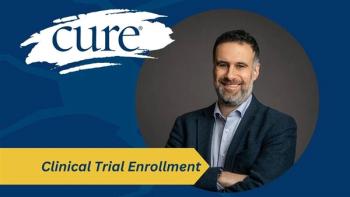
Drug Pair Benefits Patients With Melanoma Who Progressed on Prior Therapy
Combination therapy of Opdivo (nivolumab) and LAG-3 inhibitor relatlimab (BMS-986016) benefitted half of the patients with melanoma who previously progressed on an anti-PD-1 or anti-PD-L1 therapy, according to recent results from a dose-expansion study.
Paolo A. Ascierto, M.D.
Combination therapy of Opdivo (nivolumab) and LAG-3 inhibitor relatlimab (BMS-986016) benefitted half of the patients with melanoma who previously progressed on an anti-PD-1 or anti-PD-L1 therapy, according to recent results from a dose-expansion study.
The combination led to objective (measurable) responses in seven of 61 evaluable patients, increasing to 18 percent in a subgroup of patients LAG-3—positive tumors. Half of all patients treated and two-thirds of those patients with LAG-3–positive tumors derived clinical benefit, as reported at the 2017 European Society for Medical Oncology (ESMO) Congress.
“With additional follow-up, clinically meaningful antitumor activity with relatlimab and nivolumab was observed in a heavily pretreated population of patients with melanoma who had progressed during prior anti—PD-1/PD-L1 therapy,” said Paolo A. Ascierto, M.D., vice-chair of the Melanoma Unit at the National Cancer Institute Foundation G. Pascale in Naples, Italy.
“Responses were more likely in patients with LAG-3 expression greater than or equal to 1 percent, while PD-L1 expression did not appear to enrich for response. The combination is well tolerated, with a safety profile similar to that of nivolumab monotherapy. Further investigations of the combination of relatlimab and nivolumab are ongoing in melanoma and other tumor types, in both immune-oncology—naïve and immune-oncology– experienced patients.
The rationale for combining a LAG-3 inhibitor and an anti—PD-1/PD-L1 agent came from evidence suggesting that LAG-3 has a potential role in T-cell expression and anti–PD-1 resistance. LAG-3 regulates a checkpoint pathway that limits the activity of T cells, said Ascierto. Both LAG-3 and PD-1 receptors are overexpressed and/or co-expressed on tumor-infiltrating lymphocytes in melanoma.
The combination of relatlimab and Opdivo demonstrated tolerability, peripheral T-cell activation, and preliminary clinical activity in a small dose-escalation study involving patients with advanced solid tumors. The preliminary findings led to a dose-expansion study involving 262 patients with various solid tumors. Ascierto reported efficacy findings for a subgroup of 68 patients with melanoma who progressed during prior immunotherapy, as well as updated safety data for the entire expansion cohort.
The median age of the 68 patients is 60, 65 percent had ECOG performance status of 0, 68 percent had stage M1C disease without brain metastases, and 63 percent had BRAF-negative primary tumors. Almost half the patients had received 3 or more prior systemic regimens. All the patients had exposure to anti—PD-1/PD-L1 therapy, and a majority also had received anti–CTLA-4 therapy. Ascierto said 46 percent of the patients had progressive disease as a best response to a PD-1/PD-L1 inhibitor.
The overall response rate was 11.5 percent. Among 61 patients evaluable for response, one achieved a complete response (CR) to the combination of relatlimab/nivolumab and six others had partial responses (PRs). An additional 23 patients had stable disease (SD), resulting in a disease control rate (DCR) of 49 percent.
An analysis of 33 patients with LAG-3 expression 1 percent or more showed one CR, five PRs and 15 patients with stable disease, resulting in a disease control rate of 64 percent.
Analyses by baseline LAG-3 expression showed no significant difference in the efficacy of the combination among patients with PD-L1 expression less than 1 percent or more than 1 percent expression. In the subgroup of 27 patients with LAG-3 expression more than 1 and known PD-L1 expression status, the response rate of 6.3 percent in patients with PD-L1 expression more than 1 percent and 27 percent in those with PD-L1 expression less than 1 percent. PD-L1 expression status also did not influence response in 17 patients with LAG-3 expression less than 1 percent.
Patients without BRAF mutations had higher responses than those with mutations, and patients without BRAF mutations were more likely to respond if they had LAG-3 expression of at least 1 percent (24 percent vs 9.1 percent for LAG-3 under 1 percent). Patients with prior anti—CTLA-4 therapy and LAG-3 expression 1 percent or greater had a higher response rate (24 percent vs 8.3 percent no prior anti–CTLA-4 therapy and LAG-3 expression under 1 percent).
At data cutoff, 21 of 61 (34 percent) patients remained progression free, including 18 of 33 (55 percent) patients with LAG-3 expression at leat 1 percent, one of 20 with LAG-3 expression under 1 percent, and two of eight (25 percent) patients with LAG-3 status unknown.
The safety profile of the combination was similar for the subgroup of patients with prior PD-1/PD-L1 exposure and the overall expansion cohort, Ascierto reported. Grade 3/4 adverse events were uncommon, consisting of three cases each of diarrhea and colitis, and two cases of pneumonitis.





